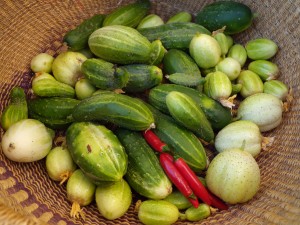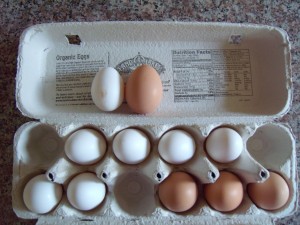It’s a lean summer in the garden. In an attempt to make less gardening work for ourselves, we opted to leave two beds unplanted. But besides that, the tomatoes haven’t done much, and the eggplant is taking its sweet time.
When I told Kelly I was going to write about our garden harvest this month, she laughed outright. But there have been a few gems.
Cucumbers
I made my second batch of pickles tonight with a combined total of 6.25 lbs. of Bushy Pickling and Lemon cucumbers. The Lemon cucumbers were impersonators—they were in amongst the Bushy Pickling and had the wrong tag. I’m keeping my fingers crossed that they turn out alright as pickles.
Serrano peppers
These sweet and spicy little peppers found a home in a few experimental jars of dill pickles. Kelly grows them to add to her Indian cooking and will dry any remaining at the end of the summer.
Dinosaur kale
We let one of our kale plants stick around this spring. It is still big and beautiful. The chickens, who were raised on kale (I suspect it’s a comfort food for them) positively adore a ration of Dinosaur kale with their daily treats. When I added it to a stir-fry, Kelly gave it more mixed reviews.
Jerusalem artichokes
They grow like weeds around the chicken coop. Kelly dug some out to clear the path recently and cooked them up as part of a quinoa salad. Delicious! I maintain that Jerusalem artichokes are one of the most under appreciated and utilized garden yums around.
Bartlett pears
Although the Comice produced a grand total of zero pears in its second year, the little Bartlett gave us seven beauties. We even managed to save them from the neighborhood squirrels, rats, and raccoons by picking them early and letting them ripen inside.
Golden Delicious apples
It’s not a great year for this apple tree, but I harvested 6.5 lbs. of apples a few days ago. The other producing apple tree (a mystery variety, perhaps Granny Smith?) is not ripe yet, but it has more fruit.
Figs
The centenarian fig tree’s fruit is starting to ripen. We picked the first figs tonight, and Kelly added them to a scrumptious baked apple, pear, fig, walnut, currant, and brandy concoction for which, tragically, there is no precise recipe.
Raspberries
The raspberries are just beginning to produce again. Think palmfuls, not basketsful of berries.
Grapes
Our first and only bunch of grapes this year was delicious. I suspect that its proximity to a beehive spared it consumption by birds and squirrels.
Eggs
The girls are keeping up egg production. Luma has missed two days of laying since the beginning of Jluy, and Petunia has missed three or four since the end of July.
Honey
I pulled two deep frames of honey from our superstar hive, Dave, at the beginning of August. We are due to make the rounds of the other hives and do more harvesting.
Wax
We melted down beeswax for the first time using our bee guild’s solar wax melter. We are now the proud owners of two slabs of wax that we will make into candles whenever we have time (ha!).
Looking toward a winter garden
With any luck we will start seeds for the winter garden in the greenhouse within the next few days. We are liking this minimized production, lower stress gardening (though Kelly misses larger quantities of produce), and are considering playing around with cover crops/bee food for the unused garden beds this winter.













